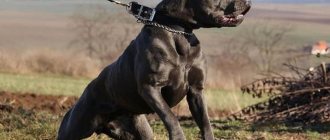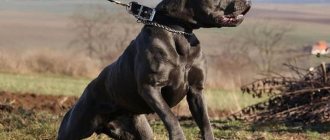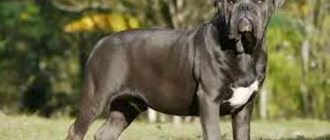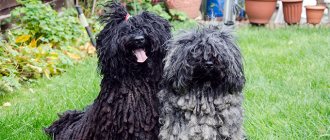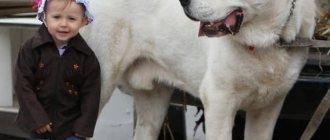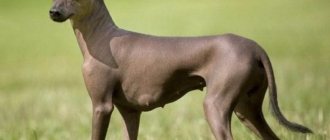China is famous not only for its large population, ancient culture, unusual and delicious dishes, but also for the special breeds of dogs that were bred in this once closed country. Many breeds date back thousands of years. The meat of some is consumed in certain regions of the Celestial Empire to this day. The peculiarity of Chinese dogs is their intelligence, in most cases their stubborn character and incredible devotion to their owners. They do not have a characteristic odor.
Hin
The Japanese Chin or Japanese Spaniel is a decorative breed that was bred specifically for representatives of the imperial palace. The Chin was considered a “female” dog, as it accompanied noble ladies on walks.
A little later, a representative of this breed was presented to the Emperor of Japan. In another interpretation of history, the breed was brought to the west of China from Japan and only then did Chinese monks begin breeding and selecting it.
The peculiarity of dogs is:
- A mischievous look resulting from eyes squinting towards the outer corner. Despite this, their character is secretive;
- This is one of the few dogs that tends to be jealous of its owner;
- Can't stand loneliness.
In Japan, this breed is the personification of Buddha. According to legend, you can’t look her in the eyes, so as not to anger her. The breed was brought to Europe in the 17th century. The classic color is red.
Shar Pei
The appearance of this canine representative is shrouded in secrets and legends. Some Chinese call them close relatives of the Chow Chow, while others classify them as Mastiffs. Shar Peis belong to the oldest family of fighting dogs. Their history goes back over 2000 years. Until the early 90s there was minimal information about them. At one time the breed was on the verge of extinction, and for the unique qualities of the Shar Pei they were included in the Guinness Book of Records.
The height of dogs of this breed is from 46 to 51 centimeters, and their weight reaches 23 kilograms. Belonging to the fighting variety, they have a gentle character. They take good care of the children. In the Middle Kingdom, they are indispensable assistants when working with children with mental disabilities.
With a good physique and high intelligence, the dog is difficult to train due to its stubborn and majestic character. You need to raise a puppy like a fighter from infancy. By nature they are cautious with strangers.
Interesting fact: there are two breeds of Shar Pei, the original Chinese one, originally from Hong Kong, and the Western one. They differ in the number of folds, of which Western representatives have more.
Personality of the Japanese Chin
Japanese Chins are distinguished by their intelligence, intelligence, and balance. They are agile, but not fussy, unexpectedly courageous, and in case of danger for themselves or their owners, their courage can develop into recklessness. The dog never retreats in front of the enemy, but since it cannot enter into battle due to its size, it spits, screams or hisses like a cat. By the way, its similarity with a cat also lies in the ability to meow, climb high surfaces, finding itself in the most unexpected places, and retire by finding a secluded corner. Chins are proud and unobtrusive - if their owners are busy, they will not bother you, but will simply wait delicately until they pay attention.
Japanese Chin and cat
These dogs are characterized by exceptional cleanliness. They are always ready to be washed and are able to take care of their fur on their own. If a couple of pets live in the house, they will happily lick each other's faces and clean their paws. Chins are completely harmless - they do not damage furniture, do not chew cords and shoes, do not create much noise, and they do not bark often.
Japanese Chins are incredibly proud and love to be admired. But they don’t like familiarity, and they are wary of strangers, not allowing themselves to be touched. When surrounded by family, these dogs show love and friendliness, while choosing a favorite that they idolize. They treat other animals, including cats, kindly and are not afraid of large dogs. Chins get along well with children, but it is not recommended to keep them in a family where the baby is growing up: a child, through negligence, can injure the animal.
Moderate activity and balanced temperament allow the Japanese Chin to feel comfortable in any family. With owners who prefer an active lifestyle, he will happily go for a long walk or jog, go swimming, and with homebodies or elderly people he will share a place on the sofa, burying himself in a pile of plush pillows. Unobtrusive and delicate, the Chin is an excellent companion for people prone to loneliness. However, all owners should keep in mind that these gentle dogs must know that they are truly loved, otherwise they will feel completely miserable.
Hins love to travel and recognize any means of transportation, be it a car, a motor boat, or an airplane. A bicycle basket will also suit them quite well.
Japanese Chin - traveler
Chow chow
Another representative of the Chinese fighting breed. It is known for its blue tongue, which is why the Chow Chow is said to have licked the roof of the mouth. This is one of the willful and independent dogs that will not attack without visible provocation. Their appearance is truly leonine, and their character is calm. They can become evil while protecting their owner. Over twenty years, about 240 fatalities involving Chow Chows were recorded.
Finding a common language with a chow-chow is problematic, but if the dog has accepted its owner, then it will feel his mood on an emotional level and have a hard time experiencing troubles in the family.
Peculiarities:
- They need to be trained daily without the use of violence, both physically and psychologically;
- A diet in which fermented milk products predominate and meat products are excluded. Judging by the photographs, it vaguely resembles a Japanese Akita Inu.
Breed overview
Dogs of the East are fluffy, downy, teddy bear-like, folded, hairless creatures of special appearance, which are divided into 3 types. Each type implies a specific breed and breeding from it (not to be confused with individual species bred for meat). And the first special species: Pekingese.
Pekingese - care tips and training ideas
And these dogs have two divisions: Japanese and Chinese. The former are distinguished by their coat and behavior (they were raised as wayward, court puppies), while the latter are famous for their appearance (very small nose, large eyes, high tear production) and loyalty in any situation.
Chinese Pekingese bear little resemblance to the Chinese Crested dog in the photo, which is often mistakenly depicted as the wrong breed. These are small creatures, more like a bundle of goodness, behaving like the true embodiment of love, and their presence in the house will not add smell or accidental mistakes - the breed is easy to learn and quickly understands a raised hand.
REFERENCE! The long-term raising of furry companions in dynasties led to the fact that the raising of their own pets fell on close subjects of the emperors. Decorative cute dogs have gone through the entire history of China and captured it inside (and outside) with their own uniqueness. If you ask: which Chinese dog is like a miniature element of tenderness in the house, then the answer will remain the same: any. REFERENCE!
Chow-chow - true to reviews
The Internet is full of information about this breed. Someone writes that this cute dog is only ready for meat, and someone claims that the dog only gets used to the strongest member of the family (most often a man), and it does not accept other people in life. Chinese Chow Chow dog puppies are under the influence of their mother from early childhood, and she is always raised in the following way (genetic setting): to protect the family and children at all costs. But, unlike the same Akita, the Chow Chow will never babysit children. A dog of this breed will be able to keep an eye on it and stay nearby, but the baby’s crying or howling will never disturb the sleeping Chow.
REFERENCE! Do not forget that every dog is the pupil of its owner. The way you make a puppy as a child determines the way he will grow up. Surrounded by affection, care and love, the puppy will grow up spoiled. But teach your dog to raise your hand, caress, sometimes shout and walk on a schedule, and the animal will greet you at the doorway with a smile (especially if it is an Akita). REFERENCE!
Chinese Crested Dog - it's time to buy him an apartment
It is not for nothing that this breed is considered the most domestic - they sleep a lot, eat little, and love to be at home. It is common for them to relieve themselves in the litter box, and to walk only for the sake of some fictitious sociality inherent in all dogs.
From the first days the puppy's body is smooth, like skin. The head, ears, paws and the entire length of the tail are equipped with tassels, and “equipped” is the right word. These tassels help them navigate in space. It is not for nothing that it is believed that the Chinese Crested Powder Dog is the most devoted oriental animal, following its owner everywhere. It often happens that a dog gets lost in space (even though it lives only in an apartment/house), and sniffs out the territory, looking for the smell of its brushes.
REFERENCE! If you decide to buy a Chinese dog, then carefully check the pedigree, find out from the owners everything about the puppy’s parents. The genetics remain in any case, but some advantages may have been lost. When choosing a Pekingese, it is worth remembering that the breed was in the “imprisonment” of the emperors for a long time, and throughout this time it became unpretentious and willful. While the Chinese Crested will follow you everywhere and reproach you with a look if you leave for work. REFERENCE!
Tibetan Mastiff
Stubborn animals that need to be treated like small children are the Tibetan Mastiff. This breed was bred specifically to protect people and homes. Having a strong build, they are distinguished by a calm disposition, but only with proper training. Without them, the Tibetan Mastiff can turn into an aggressor.
Despite their dislike for strangers and other dogs, they treat children very carefully and treat them as if they were their own puppies. Their homeland is Tibet, from which they gained their endurance and resistance to temperature fluctuations. They are distinguished by good health and long life (13 years). With an average height of 64 centimeters, the weight of a mastiff from Tibet reaches 60 kilograms. Security skills available at the genetic level will not allow him to allow strangers, including other animals, into his territory.
Health
They can live 10-12 years . The length of life depends on its quality. They have excellent health, but there are a number of diseases inherent in them. Among them: cancer, problems with the digestive system and musculoskeletal system, cataracts, corneal dystrophy, joint dysplasia, growth hormone deficiency, epilepsy, pericardium, pyoderma, dermatitis.
Unfortunately, the list is not short and these are real diseases that are most often inherent in the breed. But if you take proper care of your dog and undergo all necessary examinations on time, then no problems should arise.
It is also recommended to purchase puppies from nurseries, as they only sell healthy pets. Although these diseases are predominantly not hereditary, puppies may already have some of them at birth.
Shih Tzu
For many years, the Chinese small Shih Tzu dog was bred only by the imperial family. The small dog has silky fur that resembles flower petals on its head. The small breed has a positive character and bonds with every member of the family.
The breed is also called a small “lion”, since their height does not exceed 28 centimeters. The volume of weight is determined by the amount of wool and can reach eight kilograms. Shih Tzus are known for their playfulness and loyalty. When buying a puppy, you should be wary of his apathy and melancholy.
The Imperial is a breed that is not recognized as such by any organization of dog handlers. Many experts consider them to be a type of miniature Shih Tzu, although there are differences between them. Discussions about their pedigree have been ongoing for the past 20 years. According to other dog handlers, this breed was specially bred in the palace by Empress Cixi at the end of the 19th century. The main duty of the imperials was to warm the royal feet during sleep. To differentiate, Imperials and Shih Tzus are cut differently.
How to choose a puppy
Pekingese are a fairly popular breed, so even nurseries can be unofficial, but in order to get a high-quality healthy puppy, you need to contact only trusted services.
Healthy puppies will be playful, active and clean . They should not have obvious pathologies or deviations from the standard. The price depends on the status of the pet; a dog without a pedigree will cost 8,000 rubles , and a show-class pet suitable for exhibitions will cost 30,000 rubles.
The Pekingese is a great option for older people or single busy people. They do not need active walking or specialized training. One way or another, any dog needs care and attention, so before buying a puppy you need to make sure you are willing and able to spend time on your pet.
5 / 5 ( 1 voice )
Pekingese
The Pekingese is a small Chinese dog, which can be recognized from a photo, and has gained its popularity far beyond the borders of the Celestial Empire. This sacred dog became an excellent companion, the theft of which in ancient times was punishable by death. High standards were set for the appearance of dogs of this breed. In Europe, they were first seen only at the court of Queen Victoria, where only five representatives were brought.
These dogs are individual farmers who do not recognize anyone’s rights. Therefore, it is not advisable for families with children to have them. They have a “heavy” character and, due to the structural features of the skull, snore heavily in their sleep. The respiratory system is a weak area in the Pekingese's body. They love temperate climates and do not tolerate temperature changes.
Care and maintenance
Caring for Pekingese is not difficult, it includes regular brushing and periodic haircuts. They do not require long walks and active training. Easily adapt to any living conditions.
Despite the thick coat, the dog remains decorative and is only suitable for living indoors. They do not need a lot of free space, they love to sleep with their owner (if he allows it).
Nutrition
The Pekingese's diet should include all nutrients, vitamins and minerals. A complex diet can be high-quality premium and super-premium dry food, necessarily holistic (grain-free), or natural food, the menu of which must be carefully developed.
The diet must include:
- Lean meat, raw and boiled (chicken, lamb, veal, rabbit; about 50% of the daily diet);
- Cereals cooked in milk, water or broth (30-35%);
- Vegetables and fruits;
- Fermented milk products (milk up to 4 months, cottage cheese, kefir are allowed);
- Sea fish without bones;
- Eggs (at least 2 times a week).
Puppies are fed 5-6 times a day, adult dogs - 2 times (in the morning and in the evening after walks). The serving size depends on the pet's weight.
Health
Despite poor health and increased illness, Pekingese are real long-livers. Some representatives of the breed lived up to 22 years! On average, dogs reach 15-16 years of age . They are considered healing pets that can calm and heal. They are specially kept in some hospitals and nursing homes.
One way or another, with proper care, compliance with the vaccination schedule and regular examinations by the veterinarian, the pet will live a long time.
Vaccinations
Every pet needs protection from dangerous viral diseases, which are especially susceptible to puppies and newborn bitches. The first two vaccinations are usually done in the nursery, after which the owner himself must follow the vaccination calendar:
- Complex vaccination is done at 1.5, 2, 6, 12 months and annually;
- Rabies vaccination is given at 7 months and annually.
There are special rules, following which vaccination will take place correctly:
- The procedure is carried out only in special veterinary clinics by trained people; vaccination cannot be carried out independently;
- You cannot walk the puppy until the second vaccination;
- It is necessary to observe quarantine (14 days) after each vaccination;
- If negative consequences or symptoms appear that last longer than a day, you need to contact a veterinary clinic.
Diseases
Due to the small gene pool and indiscriminate selection, Pekingese have acquired many hereditary diseases. Most often they are associated with the structure of the muzzle and body . The main affected area is the eyes and spine.
Diseases that are most often observed in this breed:
- Cataract;
- Eversion and inversion of the eyelid;
- Weakening of the eye muscles, prolapse of the eyeball;
- Incorrect excessive growth of eyelashes (in 2-3 rows);
- Conjunctivitis;
- Displacement of the lens;
- Dermatitis;
- Hernias;
- Paralysis;
- Pathologies of intervertebral discs and joints.
In addition, cases of cardiovascular diseases and digestive problems are common. Pekingese have a thick coat, so they can overheat and die from sunstroke.
Walk
- Pekingese are not particularly active, but they need walking for the proper development of the nervous system and muscle structure.
- of 30-40 minutes twice a day is enough for them ; they walk with puppies more often - 3-4 times a day . Due to a weak bladder, it is worth accustoming your pet to the toilet at home (a special tray or diaper).
Pekingese love active games. They will be happy to run after a ball or stick, jump into puddles, and chase cats. It is worth teaching your pet to walk on a leash or without it, to follow the owner’s pace, and not to run far.
Grooming
The coat of these dogs is long and hard, the undercoat is quite thick and fluffy.
- To maintain a beautiful and well-groomed appearance, your pet needs to be brushed daily with a furminator and a long-toothed brush.
- Particular attention should be paid to the area of the muzzle, tail and ears. Many owners resort to the services of groomers; most often, Pekingese are cut for the summer.
- Dogs are bathed as they become dirty, 2-3 times a month using special shampoos. After water treatments, it is important to dry the cover thoroughly with a hairdryer at low temperature.
Particular attention should be paid to the folds on the muzzle and eyes. It is recommended to wipe them with a 1% boric acid solution using cotton swabs. The ears are examined and sulfur-dissolving substances are instilled.
Lhasa apso
Initially, these dogs lived in Tibetan monasteries and, with their barking, warned of the appearance of strangers. The Internet is replete with photographs of them and at first glance one can assume their friendly nature. In fact, this red dog breed from China has a willful disposition and will do everything to please itself, but not others. Daily training will help you develop a friendly attitude towards others.
The ability to protect is inherent at the genetic level and has developed dynamically over the centuries. The breed is named after the capital of Tibet - Lhasa. The only way to get a Chinese Inu is to receive it as a gift. It was prohibited to sell Lhasa Apso.
Chongqing
A dog that deserves special attention. This is a long-liver (20 years), whose pedigree dates back 2000 years ago. It is very rare to meet this representative outside the country, since the species is quite rare.
Chongqing is unique in its resemblance to the Chow Chow (blue tongue) and the abundance of folds with the Shar Pei. This is a large dog, whose height can reach 50 centimeters, see photo. The peculiarity is the virtual absence of wool.
Initially, they were exclusively dogs for hunting, because their character was heavy and dominant. This is especially evident in the lack of training. By taming the Chongqing, you can get a devoted comrade with whom you are not afraid to leave small children.
Xiasi quan
This is the rarest Chinese breed. The number of representatives amounts to several hundred. It is bred in Guizhou province. Outside of it, few people know these dogs. Only in Guizhou province you can buy puppies of this breed. For one white baby you need to pay 650 dollars. By the way, dogs have only one color. Representatives of the breed can only be white. Sometimes smooth-haired dogs of this species are born.
It is known that only two dogs of the Xia Si Quan breed live outside of China, with different owners.
Agility and speed are the distinctive qualities of the breed. These dogs are also very trainable.
Hunters took such dogs to the mountains to hunt. The breed was first mentioned in 1080. Representatives of the breed are hardy and strong. Dog fur protects dogs during the winter season. Representatives of the breed are well camouflaged in the snow.
In the modern world, dog fights with wild boars take place. The duration of each contraction is three minutes. The destinies estimate the number of Xia Si Quan attacks.
These dogs are devoted to their owners. They show no mercy to their prey or their enemies.
Chinese Crested
The Chinese Crested is a fashionable trend among those who want to have decorative breeds. There are two varieties - naked and with wool. Both species can be born from the same dog. The history of the appearance of the breed goes back centuries and there are still many legends around its origin.
The tail of a lion, the paws of a monkey and the crest of a crane - this was the description in the scrolls. Buddhist monks considered them the guardians of the dead, so the breed was not particularly popular. Recently, the theory of its first appearance in Asia has been called into question due to many archaeological finds in the New World.
Description
The Chinese Bulldog is a medium-sized, athletic dog, similar in build to the American Pit Bull. The animal has quite prominent muscles, clearly visible through the elastic skin with short hair. The height of males varies from 35 to 45 cm, females - from 30 to 40 cm.
Such a large difference in growth is due to the presence of 3 types of Chongqing: small, medium and large, which is explained by the formation of its own type of breed in each region. Thus, bulldogs from mountainous areas are noticeably different from lowland ones and, in comparison with them, are stockier and stronger. The weight of males, depending on the type, varies from 14 to 25 kg, females - from 12 to 20 kg.
A characteristic feature of Chinese bulldogs is a straight, thick, medium-sized tail, pointed at the end. It rises high relative to the line of the back and is completely devoid of hair. The head of the Chongqing is somewhat disproportionate in comparison with the body and looks quite large. The upper part of the skull has a flattened shape, which, in combination with clearly defined cheekbones, gives the head a square shape. The bulldog's muzzle is short and wide, which, combined with its square head, looks intimidating.
The Chinese Bulldog's tongue is uniformly black and blue, but pinkish patches are also allowed. The nose is large, black, slightly raised above the muzzle, which is quite typical for hunting dogs. The muzzle is slightly wrinkled, but the number of wrinkles is much less than in Shar-Peis and Pugs. The eyes of the Chongqing are always dark, and the hairless ears are triangular in shape, stand well and are tilted forward.
Separately, it is worth mentioning wool. In most Chinese bulldogs, it is very sparse, which is why the pets look like they are naked, and there is almost no fur on the ears, tail, and sometimes even on the face. Where fur is still present, it is short, rather hard to the touch and colored brown. Black skin is clearly visible through it, which creates the illusion of a black mask on the face, and the animal also has a black tail and ears. The dog's chest is often decorated with a white spot. Recently, the line of appearance of black color has been clearly visible, but experts consider this to be a consequence of crossbreeding - interbreeding.
As for the purpose of the breed, it belongs to the category of hunting and guard dogs, but recently there has been a tendency to keep the Chongqing dog as a companion and even a guide dog. It should be noted that only professionals can raise a dog for these purposes, so if you lack experience and lack confidence in your abilities, it is better to opt for a simpler breed.
READ American Bulldog breed description standard
Taiwanese dog
One of the hardiest breeds, whose numbers almost reached extinction, but were restored each time. They have poor stress tolerance. It takes several days to restore the psyche. They have a high level of intelligence, but do not train well due to their stubborn nature and directly show their disdain for teams.
Varieties of branched onions
Several varieties of the crop are known. The most popular are:
- Aprior. The variety is suitable for different Russian regions, is mid-early and frost-resistant. The greens are dark green and juicy, reaching 30 cm in height and 1 cm in width. You can collect 2-3 kg of greens per square meter in 3 cuts.
- Fragrant. The greenery appears early, the feathers reach 30 cm, have a dark green color and a waxy coating. A square meter of planting provides up to 4.5 kg of greenery.
- Benefit. The variety is mid-season and frost-resistant. The feathers reach 40 cm in height and have a garlicky aroma. You can collect up to 4.5 kg of greens per square meter.
- Jusay. The feather reaches 30 cm in height, has a delicate taste and a subtle garlic smell. A square meter brings up to 3 kg of greenery.
- Astrologer. Mid-season variety, greens are used fresh. The height of the feather reaches 50 cm, the greenery is abundant, and has a waxy coating. The harvest can be obtained earlier than with other varieties; a square meter of planting brings up to 3 kg of greenery.
- Caprice. Mid-season salad variety. The feather is wide, grows up to 50 cm, has a dark green color, a slightly pungent taste and a garlicky smell. A square meter of planting provides up to 3 kg of greenery.
- Spicy. The variety is mid-season and is considered a salad variety. The feather is juicy, dark green in color, and has a delicate taste with garlic notes. A square meter of planting yields up to 3.5 kg of greenery.
Let's sum it up
Chinese dog breeds are distinguished by their decorative qualities, due to which their popularity is increasing. Regardless of your choice, any dog needs to be exercised daily. Otherwise, even the most peaceful pet can turn into an aggressor.
When choosing a dog based on its breed, you should not chase fashion. The choice is influenced by the compatibility of character and temperament. You must first study all available information.
Many breeds require large amounts of space and vigorous daily walks. When taming an animal, remember that the owner is responsible for it, not only for the pet’s behavioral skills, but also for its life.
What to feed?
Due to the natural origin of the breed, its representatives should be fed only natural food. The animal's diet must include turkey, beef, chicken and lamb, as well as heart, liver, kidneys, tripe and other offal. Moreover, the share of meat should be at least 50% of the total volume, and the second half of the diet should consist of buckwheat, rice or pearl barley.
We suggest you familiarize yourself with: Black French Bulldog
Vegetables should also be on the menu. Moreover, they can be given both raw and baked. The most beneficial for the dog's body are spinach and lettuce leaves, pumpkin, cabbage, beets and zucchini. Twice a week you can give lean fish, pre-cooked and cleaned of large bones, and eggs.
Of course, you can’t offer whole milk, but fermented milk products will come in very handy. The dog will happily eat cottage cheese mixed with raw yolk and hard cheese. The animal can sometimes be pampered with dried pork and beef ears, trachea and chewing bones made from pressed veins. Under no circumstances should you feed your dog peas, beans, potatoes, corn, pickles, smoked meats, as well as bread, sweets and baked goods.
As for the frequency of meals, puppies need to be fed 5-6 times a day. For an adult animal, 2 meals a day will be enough. Bone meal, fish oil, vitamins and minerals should be given as a food supplement.


